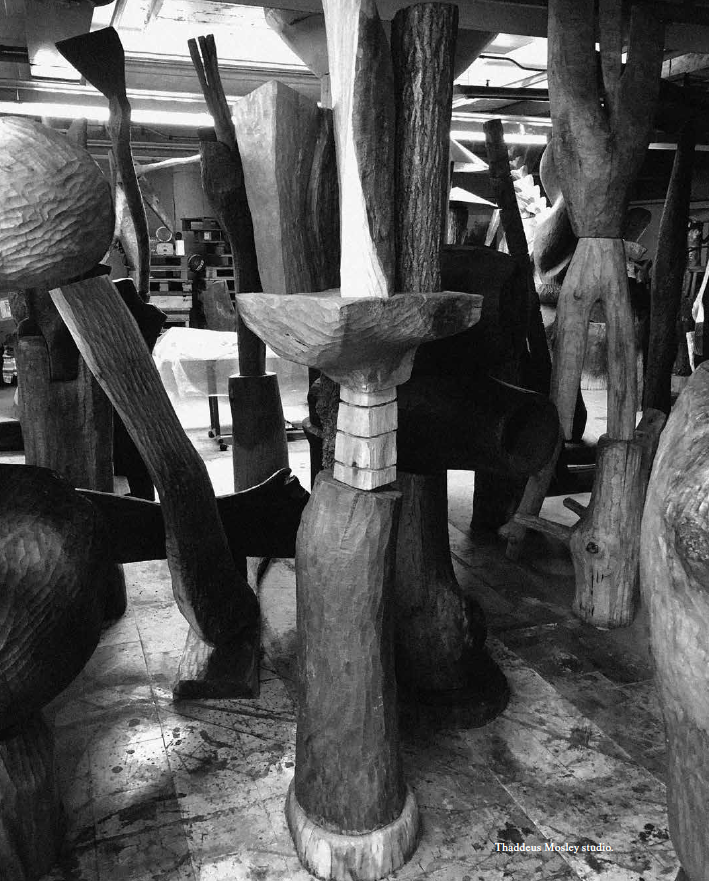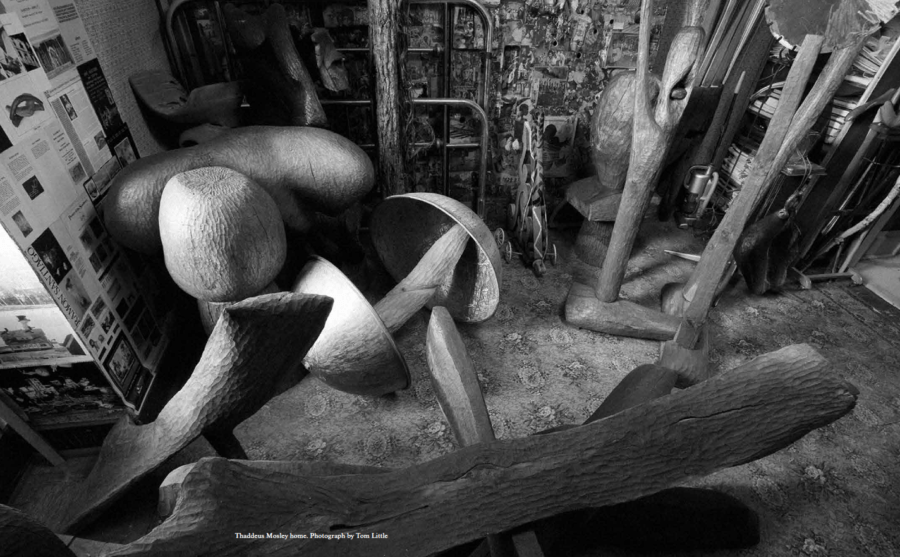February 14, 2020
Thaddeus Mosley, published by Karma, New York, 2020.
Download as PDF
Thaddeus Mosley is available here

In Aero Intersectional (2018) Thaddeus Mosley brings together three distinct formations of walnut carved into a singular presentation resembling a bird perched on a stump. In some places Mosley has treated the surface of the work, which stands at an astounding seven feet high, with oil to accentuate the wood’s natural qualities. This draws us up from the bottom register of the work toward a single point of connection at its apex. Mosley takes advantage of the practicality of mortise and tenon joints here, deceptively piecing together smaller units of wood. Producing an almost trompe l’oeil effect, like that of a painter, the artist replicates the form of bark through strategically chiseled marks and carvings. “My chisel marks are not simply surface texture. They are as important to the articulation of sculptural form as mass,” he reminds us. Mosley fabricates the appearance of precarity: he places the upper register of the sculpture in such a way that it seemingly hangs in the balance. Themes of ascendancy, resilience, and at the same time, instability emerge from Mosley’s spatial intervention here. The power of Mosley’s hand and his attentiveness to the most delicate of details is evident. Painter Sam Gilliam celebrated Mosley, his longtime friend, with poetic details about his life and work:
He was a jazz critic, post-man, father, keeper of trees anywhere-
old trees, round trees, big trees, heavy trees.
Thad is not very big,
he is short and close to the ground.
Thad is the forest.
Always maintaining a connection between the groundedness of the tree form, and its expansiveness in the forest, Gilliam keenly observes the metaphorical and allegorical spaces in which Mosley’s sculpture operates. What if we were to examine intimations of this aerial activity and locate them as a part of allegorical and ironic devices within black aesthetics? How would a cosmology of triumph over gravity unfold? I have often pondered what black flight could look or sound like. Mosley’s gravity-defying forms might offer an answer. Take Misterioso – T. Sphere Monk (2008), in which the artist makes a nod of admirtion to jazz musician Thelonius Monk. Mosley directs viewers’ eyes to travel along a form that sprouts from the earth, echoing the winding syncopation of key changes quite particular to Monk’s cyclical mode of abstraction. Umbra Workshop writer Steve Cannon once detailed a brief history of black abstraction that is critical to understanding Mosley’s sensibility as an artist amidst his generation:
Arriving from art schools and universities, self-taught artists and veterans, this generation of artists chose unconventional ways to inform themselves about the history of art—western and otherwise. Contrary to popular notions of art history, these artists were aware not only of western traditions, but also the infusion of other cultures outside that tradition. African-American artists in particular were aware of the rich history and diversity of African art, and the art of Native Americans, Latin Americans, as well as the art of Asia.
Cannon importantly marks a correlation between the coterminous maturation of jazz and black abstract art in the decade after the Civil Rights Act of 1964:
What’s fascinating about a culture which espouses the democratic spirit as personified in the poetry of Walt Whitman, the freedom of jazz and the explosion of rap music, is how the tension and agonies between freedom and equality are made manifest in works of art—in spite of, and not because of racism which haunts the society like a dream gone mad.
Cannon seems to suggest that the pursuit of political and intellectual freedom might be made manifest through aesthetic endeavors, as it was for artists creating in the two decades between the rise of Abstract Expressionism and the civil rights movement. Black artists found respite through cultural and material production despite a social and political context outwardly hostile to people of color, or at the very least, in a country that had not “manifested the promise of democracy to all its citizens.” In the land of the free, one could experience freedom as an individual, through the creation of new forms. In Mosley’s abstraction, fancies of flight and ascendance evidence a kind of strategy of self-determination. Cannon narrates a history of black abstraction through naming artists such as Ed Clark, Sam Gilliam, Mildred Thompson, Joe Overstreet, Jack Whitten, and Al Loving, among others. Many of those artists were known in the circles of New York. But in Pittsburgh, away from the nucleus of the art world, at the age of 28, Mosley began to toil with wood in his home at the end of his days working a full-time job as a postal transportation worker in the city. As a young artist Mosley did not find himself thrust within the center of dialogues on postwar abstraction, though his forms are absolutely conversant with the cohort of artists Cannon celebrates as pushing the politics of abstraction forward.

“I work mostly in wood, so the kind of art I make is hard to produce in a place like New York, anyway. In western Pennsylvania, there are a lot of saw mills, so there’s always a lot of wood. When I first started, I wasn’t too particular about the type of wood I used. Basically, I would carve anything. Early on, I got interested in African tribal art and Scandinavian design, just from reading and spending time at the Carnegie Museum,” the artist once recalled. In his sculptures, he creolizes a pan-African language of form that stretches from the European modernist avant-garde across the African diaspora. Many writers have observed Mosley’s works evoke the elongated stepladders of the Dogon people of Mali, and recall the carved wood grave markers in the slave cemeteries of Sunbury, Liberty County in coastal Georgia, inflected with Kongo cosmograms. The resonance with those forms is undeniable, as much as they resound the organic forms of Noguchi, Brancusi, and the Spanish sculptor Eduardo Chillida. Like Western artists ,Mosley reminds us that artisans and makers of the African diaspora were equally preoccupied with metaphysical questions around space, human existence, and nature. Amiri Baraka’s groundbreaking poem and treatise on black creative production, “In the Tradition,” contextualizes Mosley’s diasporic inclinations near perfectly: “our fingerprints are everywhere / on you america, our fingerprints are everywhere, Césaire told you / that, our family strewn around the world has made more parts of that world / blue and funky, cooler, flashier, hotter, afro-cuban james / brownier / a wide panafrican / world.”
Published on the occasion of
Thaddeus Mosley
February 29 – April 26, 2020
Karma
188 East 2nd Street
New York, NY 10009
Published by
Karma Books, New York
Edition of 1,000



